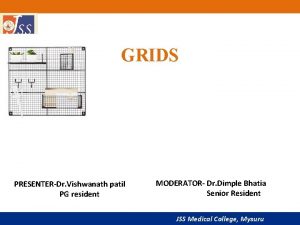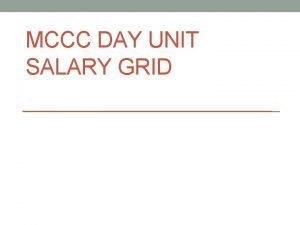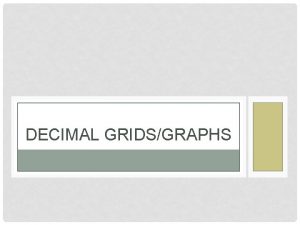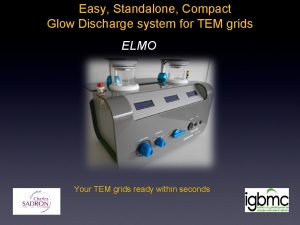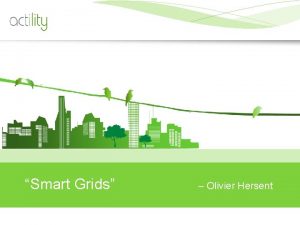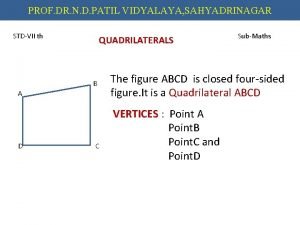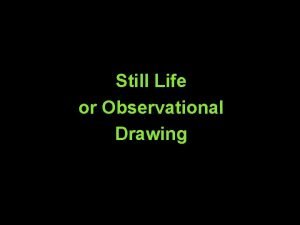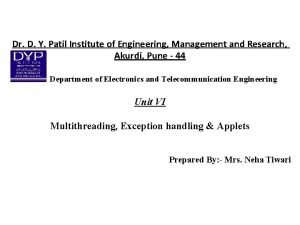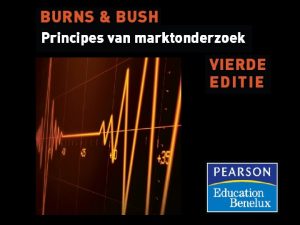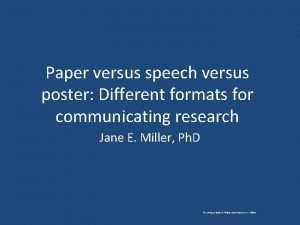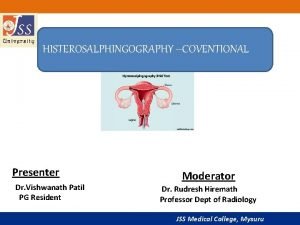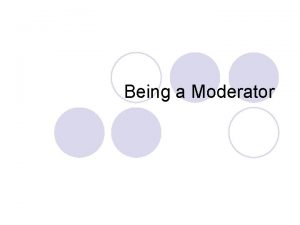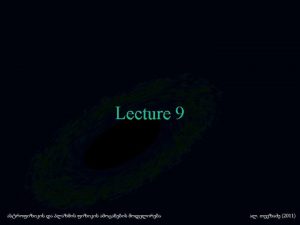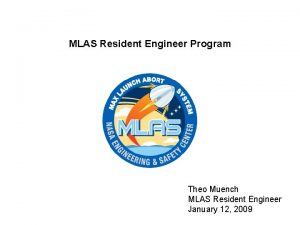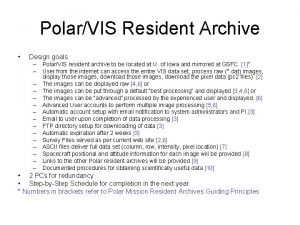GRIDS PRESENTERDr Vishwanath patil PG resident MODERATOR Dr































- Slides: 31

GRIDS PRESENTER-Dr. Vishwanath patil PG resident MODERATOR- Dr. Dimple Bhatia Senior Resident JSS Medical College, Mysuru

Scatter Control JSS Medical College, Mysuru

OUTLINE 1. Filters 2. Beam restrictors 3. Grids JSS Medical College, Mysuru

INTRODUCTION • It was invented by Dr. Gustave Bucky in 1913. • It is still the most effective way of removing scatter radiation from large radiographic fields. JSS Medical College, Mysuru

INTRODUCTION • Only rays that travel in a relatively straight line from the source are allowed to reach the film • The others are absorbed by the lead. • A high quality grid can attenuate 80 -90 percent of scatter radiation. JSS Medical College, Mysuru

Construction: • Thin lead strips alternate with interspacing material • Interspacing a)Organic (carbon-based) interspacing absorbs moisture and can potentially warp (EX: fiber, paper, cardboard, plastic). b)Inorganic interspacing is much more durable and absorbs more radiation (EX: aluminum and the less-visible lead) JSS Medical College, Mysuru

TERMINOLOGY • Grid ratio - Grid ratio = height of lead strips / distance between strips. -The grid ratio indicates how well the grid cleans up scatter (Higher ratios mean higher absorption of scatter) JSS Medical College, Mysuru

Grid Patterns • Orientation of lead strips as seen from above. �Types �Linear Their major advantage is that they allow us to angle the x-ray tube along the length of the grid without loss of primary radiation from grid "cutoff. “ �Cross hatched � 2 stacked linear grids �Ratio is sum of ratios of two linear grids �very sensitive to positioning & tilting. �Cannot be used with oblique techniques. JSS Medical College, Mysuru

Grid Styles • Parallel • Focused JSS Medical College, Mysuru

Parallel Grid • lead strips parallel • Have the same focusing distance • useful only for – small field sizes – large source to image distances JSS Medical College, Mysuru

Focused Grid • Slightly angled lead strips �Strip lines converge to a point in space called convergence line �Focal distance �distance from convergence line to grid plane �Focal range �working distance range � width depends on grid ratio � smaller ratio has greater range JSS Medical College, Mysuru

EVALUATION OF GRID PERFORMANCE • Ideal Grid • Passes all primary radiation – Reality: lead strips block some primary • Block all scattered radiation – Reality: lead strips permit some scatter to get through to film • several tests have been devised to evaluate grid performance. JSS Medical College, Mysuru

THREE METHODS OF EVALUATING PERFORMANCE: • I. primary transmission (Tp) • 2. Bucky factor (B) • 3. contrast improvement factor (K) JSS Medical College, Mysuru

METHODS OF EVALUATING PERFORMANCE: • Primary. Transmission: Measurement of the percentage of primary radiation transmitted through a grid. • Ideally 100% (never achieved) • Typical values: 55 - 75% • Theoretic calculation: (fraction of grid that is interspace) Tp (%)= 100 X W / (W+w) W = Interspace thickness w = lead strip thickness JSS Medical College, Mysuru

Primary. Transmission • Actual transmission < theoretical – Primary attenuated by interspace material – Focusing imperfections JSS Medical College, Mysuru

Bucky Factor • The Bucky factor is the ratio of the incident radiation falling on the grid to the transmitted radiation passing through the grid. • One difference: Bucky factor indicates the absorption of both primary and secondary radiation. • Indicates how much we must increase exposure factors when we change from a nongrid to a grid technique. . JSS Medical College, Mysuru

Bucky Factor • In part its also measurement of grid’s ability to absorb scattered radiation. • The higher the Bucky factor, the greater the exposure factors and radiation dosage to the patient. • IF the Bucky factor for a particular grid-energy combination is 5, then exposure factors and patient exposure both increase 5 time "s over what hey would be for the same examination without a grid. JSS Medical College, Mysuru

Contrast Improvement Factor • K =contrast with a grid/contrast without a grid • This is the ultimate test of grid performance because it is a measure of a grid's ability to improve contrast. • Unfortunately, the contrast improvement factor depends on Kvp, field size and phantom thickness. • These three factors determine the amount of scatter radiation. JSS Medical College, Mysuru

GRID CUTOFF • Grid cutoff refers to a decrease in the number of transmitted photons that reach the IR because of some misalignment of the grid. • It is the result of a poor geometric relationship between the primary beam and the lead foil strips of the grid. • Types 1. Upside-Down Focused. 2. Off-Level. 3. Off-Center. 4. Off-Focus. JSS Medical College, Mysuru

Upside-Down Focused. • Occurs when a focused grid is placed upside-down on the IR, resulting in the grid lines going opposite the angle of divergence of the x-ray beam. • Placing a focused grid upside-down on the IR causes the lateral edges of the radiograph to be very underexposed. JSS Medical College, Mysuru

Off-Level. • It is the most common type of cutoff. • Angling the x-ray tube across the grid lines or angling the grid itself during exposure produces. • Either the tube or the grid being angled. • overall decrease in exposure on the radiograph JSS Medical College, Mysuru

Off-Center(lateral decentering) • If the center of the x-ray beam is not aligned from side to side with the center of a focused grid, grid cutoff occurs. • Off-center grid cutoff appears as an overall loss of density on radiographic film. JSS Medical College, Mysuru

Off-Focus. • Off-focus grid cutoff occurs when using an SID outside of the recommended focal range. • Using an SID outside of the focal range creates a loss of exposure at the periphery of the radiograph. JSS Medical College, Mysuru

Moiré Effect • The moiré effect or zebra pattern is an artifact. JSS Medical College, Mysuru

Moving Grids • -Motion starts with second trigger • Grids move ~1 - 3 cms – must be fast enough not to see grid lines for short exposures Motion blurs out lead strip shadows JSS Medical College, Mysuru

Moving Grid Disadvantages EXPENSIVE -May limit minimum exposure time - Vibration potential -Increases patient dose – lateral decentering from motion • up to 20% loss of primary – evenly distributes radiation on film • stationary grid makes interspace gaps darker for same amount of radiation JSS Medical College, Mysuru

Grid. S • Advantage – cleanup / scatter rejection • Disadvantage – increased patient dose – increased exposure time – increase tube loading – positioning & centering more critical – EXPENSIVE JSS Medical College, Mysuru

Grid Selection • use low ratios for low k. Vp, high ratios for high k. Vp • book recommends – 8: 1 below 90 k. Vp – 12: 1 above 90 k. Vp JSS Medical College, Mysuru

Air Gap • Air gap very effective in removing scatter originating closest to film – much of scatter nearest tube doesn’t reach film • The air gap technique is an alternative to using a grid to control scatter reaching the IR. • By moving the IR away from the patient, more of the scatter radiation will miss the IR JSS Medical College, Mysuru

References • Christensen's Physics of Diagnostic Radiology. • Radiographic Imaging and Exposure 4 th Edition Terri Fauber. JSS Medical College, Mysuru

THANK YOU JSS Medical College, Mysuru
 Yashraj patil dy patil
Yashraj patil dy patil Familial hypertriglyceridemia
Familial hypertriglyceridemia Vishwanath alluri
Vishwanath alluri Sriram vishwanath
Sriram vishwanath Air gap technique
Air gap technique Salary grid
Salary grid Decimal using grids
Decimal using grids Bootstrap 4 grids
Bootstrap 4 grids Off focus grid error
Off focus grid error Grids 49152
Grids 49152 Differentiation grids
Differentiation grids Glow discharge tem
Glow discharge tem Demand response in smart grids
Demand response in smart grids Layered architecture for web services and grids
Layered architecture for web services and grids Oro traqueal
Oro traqueal Shamrao patil yadravkar
Shamrao patil yadravkar Pra n d patil
Pra n d patil Karmaveer bhaurao patil drawing
Karmaveer bhaurao patil drawing Yadravkar wada
Yadravkar wada Iwak lele duwe patil
Iwak lele duwe patil Funny patil
Funny patil Zero error by mahesh patil
Zero error by mahesh patil Kari amruta patil
Kari amruta patil Sudarshan patil dysp
Sudarshan patil dysp Rajashri patil md
Rajashri patil md Observatietechnieken
Observatietechnieken Moderatör
Moderatör Yang hu lancaster
Yang hu lancaster What is a difference between the speech and the poster
What is a difference between the speech and the poster Continuous moderator
Continuous moderator Dm80 moderator
Dm80 moderator Tugas moderator adalah
Tugas moderator adalah




